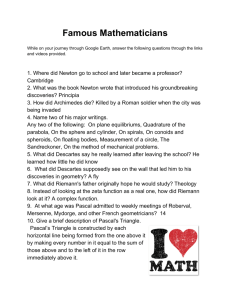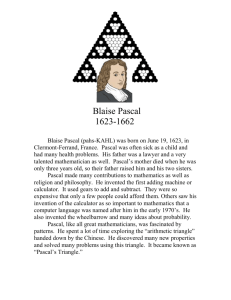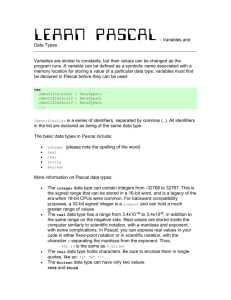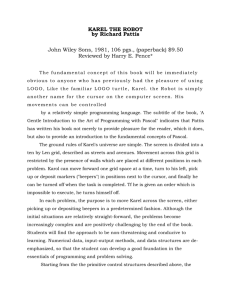II Introducing C to Pascal
advertisement
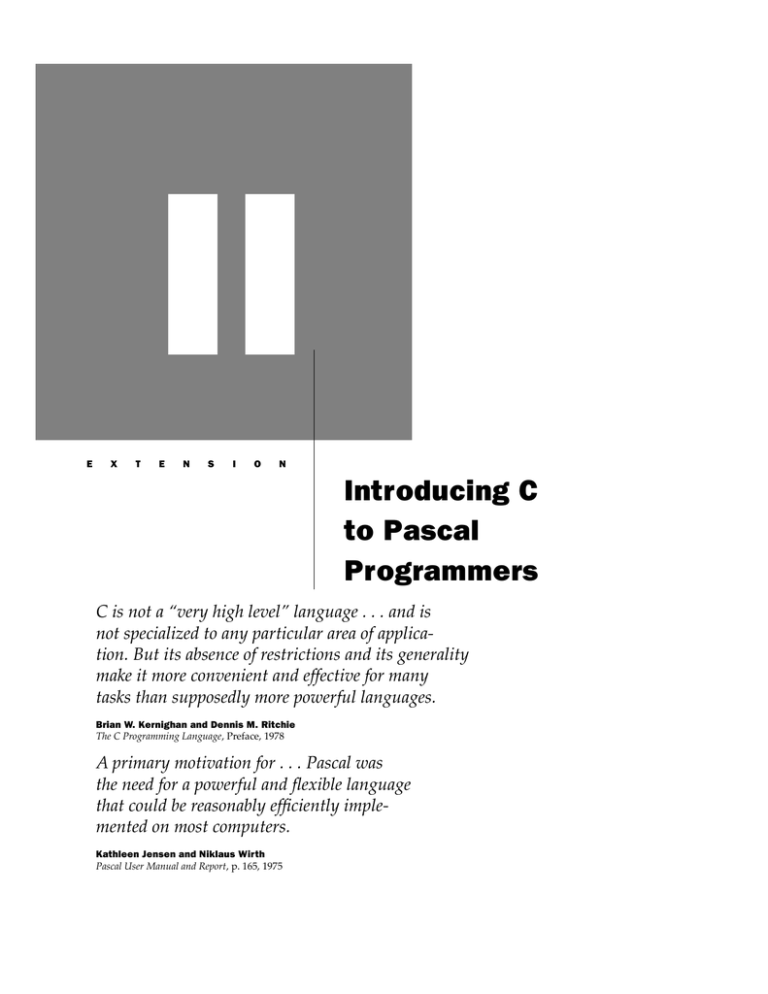
II
E
X
T
E
N
S
I
O
N
Introducing C
to Pascal
Programmers
C is not a “very high level” language . . . and is
not specialized to any particular area of application. But its absence of restrictions and its generality
make it more convenient and effective for many
tasks than supposedly more powerful languages.
Brian W. Kernighan and Dennis M. Ritchie
The C Programming Language, Preface, 1978
A primary motivation for . . . Pascal was
the need for a powerful and flexible language
that could be reasonably efficiently implemented on most computers.
Kathleen Jensen and Niklaus Wirth
Pascal User Manual and Report, p. 165, 1975
II.1
Introduction II-3
II.2
Variable Declarations II-3
II.3
Assignment Statements II-4
II.4
Relational Expressions and Conditional Statements II-5
II.5
Loops II-6
II.6
Examples to Put it All Together II-7
II.7
Exercises II-8
II.1
Introduction
II.1
This Web extension is meant for readers familiar with Pascal but not C. It is
not intended as a tutorial on how to write C programs, but as a way of allowing the reader familiar with Pascal to better understand the small amount of
C code that appears in this book. Given the level of examples in this book,
these differences are primarily syntactic.
II.2
Variable Declarations
II.2
There is no standard Pascal type for unsigned integers or double precision
floating point. Also, Pascal ignores capitalization in variable names while
II-4
Web Extension II
Introducing C to Pascal Programmers
capitalization counts in C. For example, Apple and apple are different variables in C. Here are the corresponding standard types:
C declaration
Type
int
float
unsigned int
double
Integer
Single precision floating point
Unsigned integer
Double precision floating point
II.3
Pascal declaration
integer
real
?
?
Assignment Statements
II.3
The primary difference is that C uses the “=” while Pascal uses “:=” to indicate an assignment. Here are C examples from the book with their equivalents
in Pascal.
Corresponding Pascal code
Examples in C
a = b + c;
d = a – e;
f = (g + h) – (i + j);
g = h + P[i];
P[i] = h + P[i];
a :=
d :=
f :=
g :=
P[i]
b + c;
a – e;
(g + h) – (i + j);
h + P[i];
:= h + P[i];
In addition to standard arithmetic operators (+,–,*,/), C has some logical operators sometimes found as library routines in other languages.
Logical operations
Shift Left
Shift Right
AND
OR
XOR
NOT
C operator
<<
>>
&
|
^
~
Operators << and >> are logical operations only on unsigned integers in C.
II.4
II.4
II-5
Relational Expressions and Conditional Statements
Relational Expressions
and Conditional Statements
II.4
There is more difference in the if statements of the two programming languages, both in the statements themselves and in the expressions that commonly occur. C leaves off the keyword “then” in the traditional if statement,
and since “=” is used to mean assignment, new symbols are used to mean
relational equality. The table below shows the mapping of the relational operators in both languages:
Operation
Equal
Not equal
Less than
Less than or equal
Greater than
Greater than or equal
C
Pascal
==
!=
<
<=
>
>=
=
<>
<
<=
>
>=
if i = j
else
if i = j
f := g +
f := f –
then f := g + h
f := g – h;
then goto 1;
h;
i;
Here are two examples of if statements.
Pascal
C
if (i == j) f = g + h;
else f = g – h;
if (i == j) goto L1;
f = g + h;
L1:f = f – i;
1:
C replaces the begin end of Pascal’s compound statements with { }.
The case statement in Pascal is quite similar to the switch statement in C.
Each switching alternative in C starts with the keyword “case” and ends with
the keyword “break.” Here are equivalent statements:
Pascal
C
switch (k)
case 0:
case 1:
case 2:
case 3:
};
{
f
f
f
f
=
=
=
=
i
g
g
i
+
+
–
–
j;
h;
h;
j;
break;
break;
break;
break;
case k of
0: f :=
1: f :=
2: f :=
3: f :=
end;
i
g
g
i
+
+
–
–
j;
h;
h;
j;
II-6
Web Extension II
II.5
Introducing C to Pascal Programmers
Loops
II.5
The while loops are almost identical in the two languages. Here is an example:
Pascal
C
while (save[i] == k)
i = i + j;
while save[i] = k do
i := i + j;
Of course, while loops can be constructed from gotos:
C
Loop:
Pascal
g = g + P[i];
2:
g := g + P[i];
i = i + j;
i := i + j;
if (i != h) goto Loop;
if i <> h then goto 2;
The for statement may be the most unusual. In keeping with the philosophy
of no restrictions, the initialization, exit test, and per loop operation can be any
statements. They appear in three pieces in that order in the for statement:
C
Pascal
for (i = 0; i < n; i = i + 1)
{...}
for i := 0 to n – 1 do
begin ... end
In addition to the relational operators, there are logical relational operators
to connect conditions. Here they are in the two languages:
Operation
And
Or
Not
C
Pascal
&&
||
!
and
or
not
II.6
II-7
Examples to Put it All Together
This example shows some of the power of the for statement; the compound
exit test requires nested statements in Pascal.
C
Pascal
for j := i – 1 downto 0 do
if v[j] > v[j + 1] then
begin ... end
else goto 3;
for (j = i – 1; j >= 0
&& v[j] > v[j + 1]; j = j – 1)
{ ... }
3:
II.6
...
Examples to Put it All Together
II.6
Procedures in C and Pascal are quite similar. The primary difference is that
arrays are normally declared as types, with the type name used to declare
array variables:
C
Pascal
type
names = array [0..19] of integer;
swap (int v[], int k)
{
int temp;
temp
= v[k];
v[k]
= v[k + 1];
v[k + 1] = temp;
};
...
procedure swap (var v: names;
k: integer);
var
temp: integer;
begin
temp
:= v[k];
v[k]
:= v[k + 1];
v[k + 1] := temp
end;
II-8
Web Extension II
Introducing C to Pascal Programmers
Here is a longer example::
C
sort (int v[], int n)
{
int i, j;
for (i = 0; i < n; i = i + 1)
for (j = i–1; j >= 0 &&
v[j] > v[j + 1]; j = j – 1)
swap(v,j);
};
Pascal
procedure sort (var v: names;
n: integer);
var
i, j: integer;
begin
for i := 0 to n - 1 do
for j := i – 1 downto 0 do
if v[j] > v[j + 1] then
swap(v,j)
else goto 4;
4: ;
end;
To Probe Further
Kernighan, Brian W., and Dennis M. Ritchie [1988]. The C Programming Language, 2nd edition,
Prentice Hall, Englewood Cliffs, N.J.
This classic text is so widely used it’s known as “K&R”; be sure to get the second edition. The first section,
which is a tutorial, is a good introduction to C for someone who knows how to program.
Tondo, Clovis L., and Scott E. Gimpel [1989]. The C Answer Book: Solutions to the Exercises in the C
Programming Language, 2nd edition, Prentice Hall, Englewood Cliffs, N.J.
The second edition of this book has the answers to the exercises in the second edition of K&R.
II.7
Exercises
II.7
II.1 [5] Write a Pascal version of the C program for summing shown in Appendix A, Figure A.5 on page A-8.
II.2 [5] Write a Pascal version of the first C procedure to set an array to zero,
Clear1, shown in Chapter 3, Figure 3.27 on page 171.
II.3 [10] Write a Pascal version of the second C procedure to set an array to
zero, Clear2, shown in Chapter 3, Figure 3.27 on page 171.
